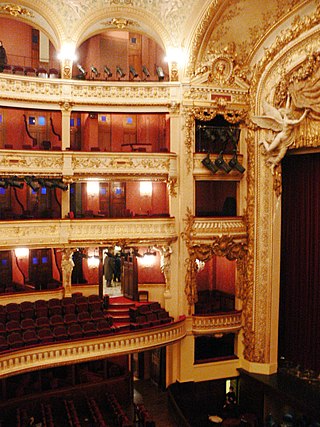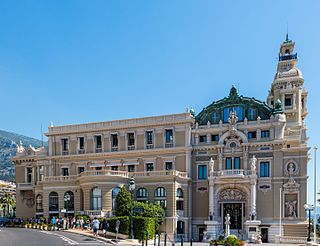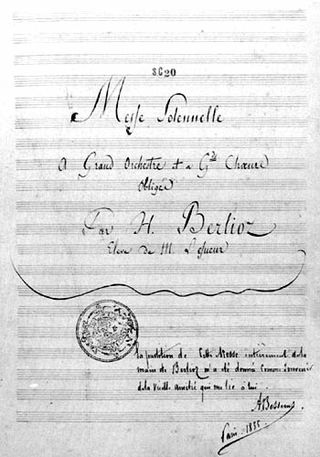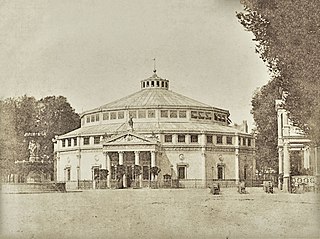
Jacques Offenbach was a German-born French composer, cellist and impresario. He is remembered for his nearly 100 operettas of the 1850s to the 1870s, and his uncompleted opera The Tales of Hoffmann. He was a powerful influence on later composers of the operetta genre, particularly Franz von Suppé, Johann Strauss II and Arthur Sullivan. His best-known works were continually revived during the 20th century, and many of his operettas continue to be staged in the 21st. The Tales of Hoffmann remains part of the standard opera repertory.

La damnation de Faust, Op. 24 is a work for four solo voices, full seven-part chorus, large children's chorus and orchestra by the French composer Hector Berlioz. He called it a "légende dramatique". It was first performed at the Opéra-Comique in Paris on 6 December 1846.

The Conservatoire de Paris, also known as the Paris Conservatory, is a college of music and dance founded in 1795. Officially known as the Conservatoire National Supérieur de Musique et de Danse de Paris (CNSMDP), it is situated in the avenue Jean Jaurès in the 19th arrondissement of Paris, France. The Conservatoire offers instruction in music and dance, drawing on the traditions of the 'French School'.

The Opéra-Comique is a Paris opera company which was founded around 1714 by some of the popular theatres of the Parisian fairs. In 1762 the company was merged with – and for a time took the name of – its chief rival, the Comédie-Italienne at the Hôtel de Bourgogne. It was also called the Théâtre-Italien up to about 1793, when it again became most commonly known as the Opéra-Comique. Today the company's official name is Théâtre national de l'Opéra-Comique, and its theatre, with a capacity of around 1,248 seats, sometimes referred to as the Salle Favart, is located at Place Boïeldieu in the 2nd arrondissement of Paris, not far from the Palais Garnier, one of the theatres of the Paris Opéra. The musicians and others associated with the Opéra-Comique have made important contributions to operatic history and tradition in France and to French opera. Its current mission is to reconnect with its history and discover its unique repertoire to ensure production and dissemination of operas for the wider public. Mainstays of the repertory at the Opéra-Comique during its history have included the following works which have each been performed more than 1,000 times by the company: Cavalleria Rusticana, Le chalet, La dame blanche, Le domino noir, La fille du régiment, Lakmé, Manon, Mignon, Les noces de Jeannette, Le pré aux clercs, Tosca, La bohème, Werther and Carmen, the last having been performed more than 2,500 times.

The Opéra de Monte-Carlo is an opera house which is part of the Monte Carlo Casino located in the Principality of Monaco.

Henri Herz was a virtuoso pianist, composer and piano manufacturer, Austrian by birth and French by nationality and domicile. He was a professor in the Paris Conservatoire for more than thirty years. Among his major works are eight piano concertos, a piano sonata, rondos, nocturnes, waltzes, marches, fantasias, and numerous sets of variations.

The Salle Le Peletier or Lepeletier was the home of the Paris Opera from 1821 until the building was destroyed by fire in 1873. The theatre was designed and constructed by the architect François Debret on the site of the garden of the Hôtel de Choiseul on the rue Lepeletier. Due to the many changes in government and management during the theatre's existence, it had a number of different official names, the most important of which were: Théâtre de l'Académie Royale de Musique (1821–1848), Opéra-Théâtre de la Nation (1848–1850), Théâtre de l'Académie Nationale de Musique (1850–1852), Théâtre de l'Académie Impériale de Musique (1852–1854), Théâtre Impérial de l'Opéra (1854–1870), and Théâtre National de l'Opéra (1870–1873).

The Théâtre des Bouffes-Parisiens is a Parisian theatre founded in 1855 by the composer Jacques Offenbach for the performance of opéra bouffe and operetta. The current theatre is located in the 2nd arrondissement at 4 rue Monsigny with an entrance at the back at 65 Passage Choiseul. In the 19th century the theatre was often referred to as the Salle Choiseul. With the decline in popularity of operetta after 1870, the theatre expanded its repertory to include comedies. The theatre is still active with regular productions of stage plays.

Messe solennelle is a setting of the Catholic missa solemnis by the French composer Hector Berlioz. It was written in 1824, when the composer was twenty, and first performed at the Saint-Roch, Paris, on 10 July 1825, and again at the Saint-Eustache in 1827. After this, Berlioz claimed to have destroyed the entire score, except for the Resurrexit, but in 1991 a Belgian schoolteacher, Frans Moors, came across a copy of the work in an organ gallery in Antwerp, and it has since been revived.

French composer Hector Berlioz wrote a number of "overtures", many of which have become popular concert works. They include true overtures, intended to introduce operas, but also independent concert overtures that are in effect the first orchestral tone poems.

Jules Danbé was a French violinist, composer and conductor, mainly of opera.

The Salle Ventadour, a former Parisian theatre in the rue Neuve-Ventadour, now the rue Méhul, was built between 1826 and 1829 for the Opéra-Comique, to designs by Jacques-Marie Huvé, a prominent architect. The original theatre had a capacity of 1,106, but was subsequently taken over by the Théâtre-Italien and expanded to a capacity of 1,295 in 1841, thereafter becoming perhaps most noteworthy as the theatre in which the majority of the operas of the Italian composer Giuseppe Verdi were first performed in France. When the Théâtre-Italien company went out of business in 1878, the theatre was converted to offices.

The Cirque d'Été, a former Parisian equestrian theatre, was built in 1841 to designs by the architect Jacques Hittorff. It was used as the summer home of the Théâtre Franconi, the equestrian troupe of the Cirque Olympique, the license for which had been sold in 1836 to Louis Dejean by Adolphe Franconi, the grandson of its founder, Antonio Franconi. The cirque was later also used for other purposes, including grand concerts conducted by Hector Berlioz.
Jean Giraudeau, was an artist and French tenor, and later theatre director, particularly associated with the Opéra-Comique in Paris, and described in Grove as having a “lyrical voice” as well as being “a superb character actor”. He left a wide selection of recordings from both his operatic and concert repertoire, and created roles in several contemporary operas.

La Gaîté Lyrique is a digital arts and modern music centre opened by the City of Paris in December 2010, located at 3-5 rue Papin in the 3rd arrondissement.
Le désert is an "ode-symphonie" in three parts by the French composer Félicien David with words by fellow Saint-Simonien Auguste Colin, written after the composer's stay in Egypt and the Holy Land.

Alexis Dupont was a French operatic tenor who sang at the Opéra-Comique from 1821 to 1823 and the Paris Opera from 1826 to 1841. There he created a number of roles in operas by Rossini, Auber, Halévy and Meyerbeer. He had a significant association with Berlioz, creating the tenor solo in Roméo et Juliette in 1839; and he sang in the Mozart Requiem at Chopin's funeral in 1849.

Henri Valentino was a French conductor and violinist. From 1824 to 1832, he was co-conductor of the Paris Opera, where he prepared and conducted the premieres of the first two grand operas, Auber's La muette de Portici and Rossini's Guillaume Tell. From 1832 to 1836, he was First Conductor of the Opéra-Comique, and from 1837 to 1841, conductor of classical music at the Concerts Valentino in a hall on the rue Saint-Honoré in Paris.
The style of architecture and design under King Louis Philippe I (1830–1848) was a more eclectic development of French neoclassicism, incorporating elements of neo-Gothic and other styles. It was the first French decorative style imposed not by royalty, but by the tastes of the growing French upper class. In painting, neoclassicism and romanticism contended to become the dominant style. In literature and music, France had a golden age, as the home of Frédéric Chopin, Franz Liszt, Victor Hugo, Honoré de Balzac, and other major poets and artists.

Henri Tayau was an operetta singer and actor, and violinist, who during a short but successful career performed many light tenor roles in opéra-bouffes of Offenbach, and created several roles, the most notable being that of Orphée in Offenbach's greatest success, Orphée aux Enfers.

















